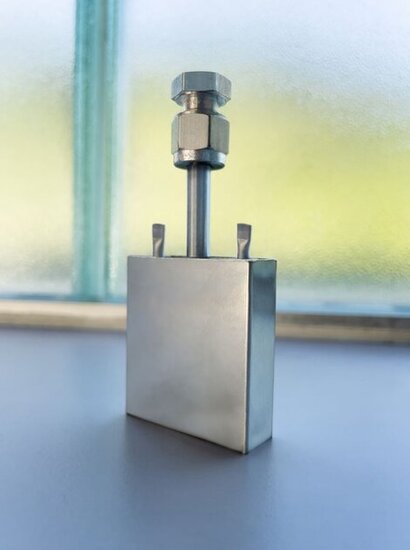
The applications range from stationary storage for home and industrial use to charging infrastructures and the mobility segment – such as the automotive industry. The data and properties measured so far show significantly better values and characteristics compared to the currently dominant lithium-ion batteries.
Longevity: While conventional lithium-ion batteries have to be replaced after about 1,250 charging cycles – with hourly charging and discharging – the HPB solid-state battery currently has at least 12,500 charging cycles, with a comparable load. Since these cells have not yet reached the end of their life, this number will continue to increase steadily.
Safety: The new HPB solid-state electrolyte is non-flammable and thus considerably safer than the flammable liquid electrolytes of conventional lithium-ion batteries.
Sustainability: The HPB solid-state battery shows a 50 percent better environmental balance compared to current lithium-ion technology. This makes it the “green key to the energy and mobility revolution”.
Conductivity: Compared to the liquid electrolytes commonly used today, the HPB solid-state electrolyte has an enormously improved conductivity. This is decisive for the available power from the battery cell. The HPB solid-state electrolyte shows an absolutely higher conductivity at minus 40 °C than conventional liquid electrolytes at their optimum at plus 60 °C. These properties have been confirmed by independent partners and research institutes in the temperature range from minus 40 °C to plus 60 °C.
For the automotive industry, which develops its own high-performance rechargeable batteries, HPB provides its safe, robust and outstandingly conductive HPB solid-state electrolyte.
In this way, the HPB solid-state electrolyte ensures that sufficient power is available even at extreme temperatures. This eliminates the need to preheat the batteries in winter.
Overall, HPB solid-state batteries and HPB solid-state electrolyte make an important contribution to the energy and mobility transition and to reducing dependence on raw materials. While the annual demand for storage was still 180 gigawatt-hours in 2018, it is expected to exceed 2,000 gigawatthours by 2030.
The longevity of the HPB solid-state battery improves the economic efficiency of battery storage – across the board in all areas of application. Above all, the combination of individual applications on the same storage unit requires a long service life. This is a financially attractive approach that is often blocked to conventional lithium-ion technology. The energy transition is becoming affordable in the storage segment.
The longevity of the HPB solid-state battery means less raw material use, as the replacement cycles can be significantly extended. The primary materials used can be procured worldwide without any problems. This means that current geopolitical dependencies can also be overcome in the future.
According to the website Flash Battery Tech, the latest studies on solid state batteries show that they have an energy density 2-2.5 times higher than current lithium-ion technology. This would deliver a lighter and smaller battery capable of enabling greater range and lighter weight.
Absolute certainty on this will only be available when the technology has properly matured, but in theory, this would increase the capacity of a 54 Kwh EV to 108-135 Kwh, thereby increasing its range on full charge to 400-500 miles.
According to the latest studies, solid-state batteries have an energy density 2-2.5 times higher than current lithium-ion technology and this huge advantage would result in a lighter and smaller battery. This is certainly a breakthrough for electric mobility, which would benefit from greater range and a lighter weight, but let’s remember that we will only be certain of this figure when this technology is officially ready.
HPB’s licensing model is intended to allow a rapid market introduction of the new technology in many fields of application and regions of the world. HPB is in contact with a number of potential licensees who have expressed great interest in the technology.
“We are not only opening a new chapter in battery technology but are also making a decisive contribution to the energy transition and climate protection worldwide” said Sebastian Heinz, CEO of HPB. “We are already holding intensive talks – not only in Germany and Europe. In India, too, people are very open to implementing our technology. In Switzerland, a gigafactory is already being planned that will cover the Swiss market and produce for further licensees.”
For additional information:

